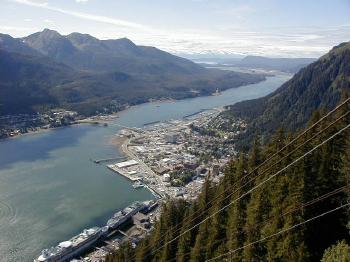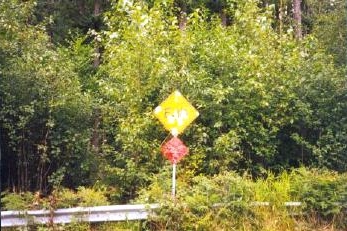Juneau is located in Alaska’s southeastern panhandle and serves as the state capital. No roads connect Juneau to the outside world even though it’s clearly part of mainland North America. Access is by sea or by air only. Rather than describe the situation it’s easier to show it.
Notice how Juneau hugs a narrow seaside plain. Go ahead and zoom out and consider the difficulties inherent in building a road across this terrain.
It didn’t matter so much when Juneau was founded in the 1880’s and people traveled by ship. The water served as the highway and the town was as accessible as any other seaside locale. It only became an anomaly with the rise and domination of our current automobile culture.
A Better Demonstration

Here is the same situation portrayed pictorially. I took this photograph in July 2000 from the top of the Mount Roberts Tramway. Juneau sits far below on a flat ledge hemmed in by the Gastineau Channel and a wall of high coastal mountains.
From this spot, less than a mile from a sea-level shoreline, the elevation gain is already about 1,500 feet! It gets much higher very quickly and soon reaches 3,500-4,000 feet. And if that weren’t enough, the ridge hosts a glacial icefield that pushes down into the valleys. It would be foolhardy to try to put a road up through the icefield if indeed it were even possible. Instead people “drive” out of town via ferryboat, the famed Alaska Marine Highway. Or usually they just fly out as we did.
That’s not to say there aren’t roads in Juneau or that there’s no room to expand. Look back at the photo and notice the bridge crossing between Juneau and Douglas Island. Douglas is truly an island. It increases habitable space near downtown but it does not provide access to the larger world beyond.
There is also room to grow along the coastline. Roads push north through the small gap that rests between mountain and water. Development takes place wherever the gap widens. The Mendenhall Valley opens onto a broad plain several miles from downtown. It includes sufficient space for Juneau’s international airport as well as a large percentage of the population housed in subdivisions along the very raftable Mendenhall River. This is suburban sprawl, Juneau-style (which is to say not much sprawl at all).
However, the Road Ends

The Glacier Highway / Veterans Memorial Highway continues generally north from downtown for perhaps 50 miles. Even so it stops far short of Haines or Skagway and the access they could provide to an external road network. I took this photograph in 1995 where the road abruptly terminated at a guardrail, appropriately marked with a sign that read “END.” I understand that it has since been paved another 10 miles or more. Even though Juneau is not an island technically, it certainly feels like one and it has a lot of the same attributes.

Leave a Reply